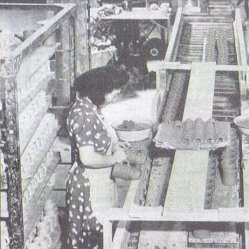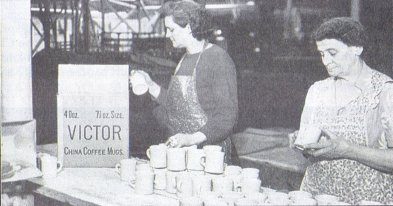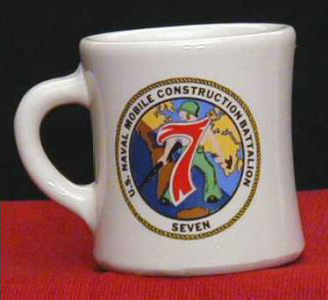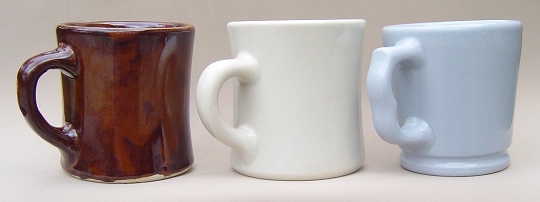Someone wrote recently asking if the Victor mugs were actually made at the
insulator factory in Victor, NY. We haven't discussed the Victor chinaware in
many years. Now that I have much more information about them, thought you would
like to learn more about this interesting go-with. First, Locke Insulator Mfg.
Co did not make the mugs. The Victor, NY factory was started by Fred Locke in
1898 and incorporated as Locke Insulator Mfg. Co. in 1902. Locke closed the
factory in 1928 preferring to expand their operation in Baltimore. The idle
factory was reopened in 1935 as Victor Insulators, Inc. ITE bought the factory
in 1953. It was later sold to Gould, Inc. (1976), Brown Boveri & Co. (1981),
and the employees purchased the factory in 1984 to return the name to Victor
Insulators, Inc. Today it is one of two remaining plants in the U.S. that make
porcelain pin-type insulators.
In 1945, Victor Insulators published a 24-page
booklet titled "A Story of Victor". It describes how insulators were
made at the insulator factory. Here is what they said about their "Heavy
Duty Chinaware":
"Several years ago an investigation was made by
Victor Insulators, Inc., to determine the advisability of manufacturing
additional products. Although the insulator business is not seasonal in the same
way that many industries are, the management felt that additional products would
provide steady employment and insure weekly wages year 'round for Victor's
employees."
"As a result of this study it was decided to start the
fabrication of high quality, heavy duty chinaware - a product manufactured from
the same raw materials as insulators and a process that would utilize similar
ceramic production methods and craftsmanship."
"The war gave impetus
to the development of the chinaware business. Orders for great quantities of
rugged cups and bowIs built to military specifications have been and are being
delivered to the Army and Navy."

Affixing handles to mugs.

Taking mugs from glazing machine.
"At present a substantial part of Victor's business is devoted to the
production of Victor chinaware for the armed services."
"In the
postwar era, steady employment for scores of new workers is planned to take care
of the increasing demand for this type of chinaware."
A newspaper article
has more details about the Victor mugs. The "Democrat and Chronicle"
of Rochester, NY ran an article on July 14, 1991, titled "Victor Mugs'
Owners Can't Get a Refill". It announced that the Victor factory had
stopped making the mugs. Businesses such as a Canandaigua, NY donut shop and a
Martha's Vineyard bakery and restaurant, The Black Dog, which sold the mugs in
their mail-order business, could not obtain the popular mugs any more. The Black
Dog used them for 20 years in their restaurant and sold 10,000 in their catalog
business since 1988 decorated with a black dog decal. The Victor mug could be
found in restaurants all over the U.S. The Victor mug was almost indestructible.
It was solid and seldom broke when dropped with the handle being the only weak
part. Each mug was stamped VICTOR on the bottom.
In the spring of 1990, Victor
Insulators shut down production of its famous diner mug, a unique cream-colored
cylinder with convex sides and a solid handle. It was produced in several
varieties and held less than 8 oz. of coffee, but its shape lent itself to
warming one's hands. The company needed to sell 25,000 to 30,000 dozen mugs
annually to make the business profitable, but only had orders for about 60% that
amount. They blamed the drop in orders on Ultima China, a company in China,
which started making a look-alike mug about five years earlier that sold for
less than half the price. In July 1996, Victor Insulators added "MADE IN
U.S.A." to the "VICTOR" stamp on the bottom, but they could not
compete with the China-made lighter weight version, which only had
"CHINA" stamped on the bottom.

Final inspection preparatory to packing and shipping.
The article said that the Victor mugs were originally used on Navy ships
because the mugs did not tip over easily. The Navy would place orders for 1
million at a time. Later during the war the Army started placing orders. The
handle-less military version was popular stateside, too. Victor sold the mugs
through an exclusive agreement with Buffalo China to sell the mugs commercially.
Victor also made cereal and soup bowls for Buffalo China until the company found
they could make the bowls cheaper with labor that was lower cost than that paid
in the electrical porcelain industry. Victor continued to make the mugs and sell
directly to businesses.

"Roadside", a journal devoted to the
appreciation of the American diner, ran an article in their spring 1994
publication about the Victor mugs. It provided a description of how the mugs
were made. A plug of soft clay was placed in a mold and a plunger lowered to
press out the inside cavity. The clay form was then placed on a spinning
"bat" and a blade pressed up against the outside to cut out the convex
profile. The handles were cast from liquid clay poured in plaster molds. The
handles were then dipped in clay slip to aid in binding it to the mug. Applying
the handles to the mug was the most difficult operation of producing the mugs.
There were only three women who worked as "handle stickers". They
could smooth the handle better because they had smaller fingers. Each woman had
her own slightly different "VICTOR" stamp so flaws could be traced
back. The completed mug was then dipped by hand into liquid glaze and placed on
a rack to dry. Victor mugs were produced in a variety of glaze colors: white,
black, mahogany, sky-gray, chocolate, light blue, and white with a green stripe
around the lip. The green stripe was painted on by hand by one of the
"handle stickers" as the mug spun on a bat. One particular rare and
unusual Victor mug was made in the early 1970's by a supervisor as a Christmas
gift for the "big bosses". Only 2,000 were made with a rich
cobalt-blue glaze.
The mugs were" dry footed", which means the foot of
the mug was wiped on a wet rubber mat. This prevented the mug from sticking to
the kiln shelf when it was fired in the kiln at 2250F, which fused the clay into
porcelain and the glaze to the mug. It took 72 hours to fire the mugs. The mug
could withstand 765,000 volts of electricity, but could not withstand
competition from China. The "Roadside" stated production of the mugs
was halted in the spring of 1991. Perhaps the 1991 newspaper article was a
misprint by stating spring of 1990. It was obvious to Victor employees that the
Chinese company used one of Ida's mugs to make the mold for their cheap
knock-off copy of the Victor mug. Ida was a veteran Victor "handle
sticker" and her handles were always "a little crooked".


Here are three examples of Victor mugs. The one on the left is an earlier
production with a mottled reddish brown glaze. It has a wax-resist firing rest
with a fully glazed bottom with "VICTOR" stamp. The cream-colored mug
in the center was made after July 1986 when the "MADE IN U.S.A." was
added to the "VICTOR" stamp. The mug on the right is a
non-conventional design. It has straight sides, an indention around the bottom,
and a two-finger handle. It has "VICTOR" stamped on the bottom, but
the design was made for a special occasion and stamped in the bottom of the mug
with an under-glaze dark blue ink marking that reads:
OPEN HOUSE
VICTOR INSULATORS,
INC.
APRIL 28,1948


































































